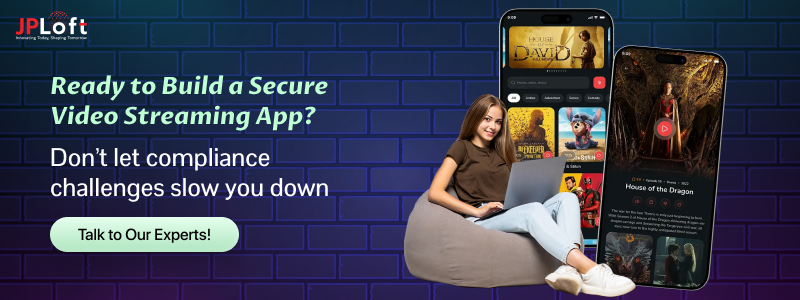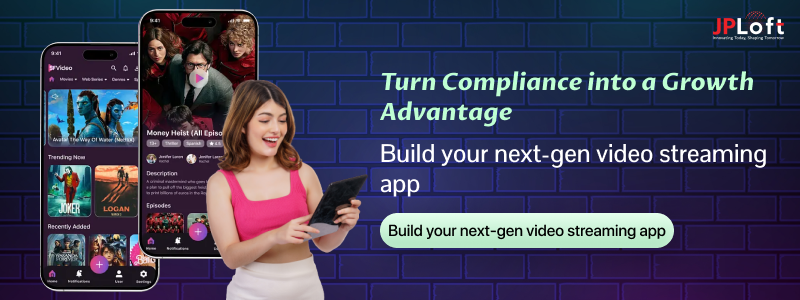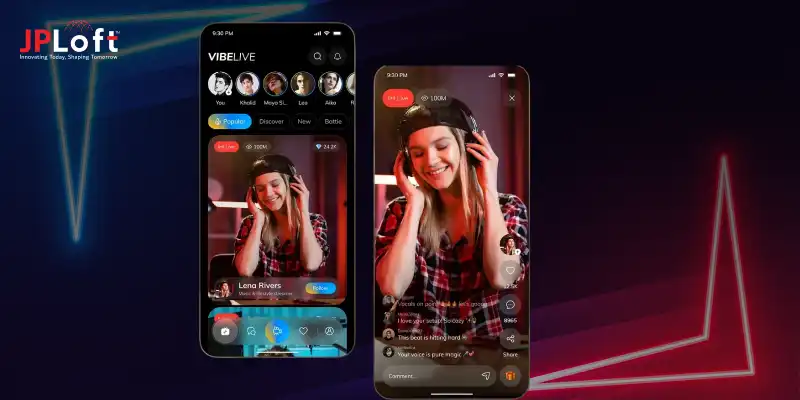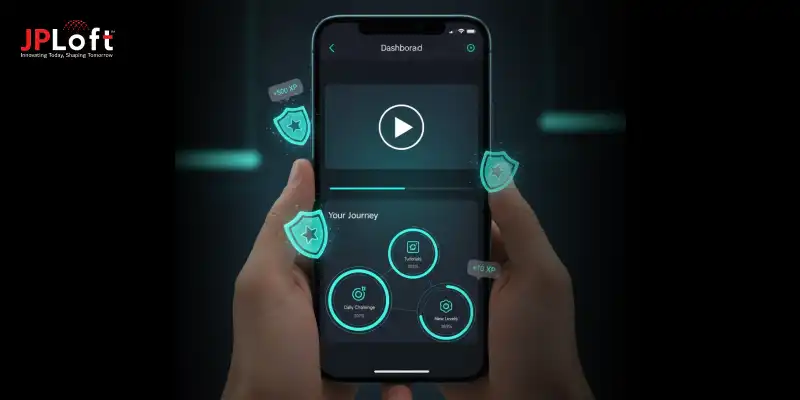Key Takeaways
A strong video streaming app compliance checklist protects platforms from lawsuits, penalties, and security breaches while boosting long-term user trust.
Key compliances for video streaming apps include data privacy, DRM, copyright, payment compliance, accessibility, advertising transparency, and regional broadcasting laws.
Data privacy in video streaming apps is non-negotiable; businesses must follow GDPR, CCPA, and similar frameworks to protect sensitive user information.
Integrating DRM compliance for streaming platforms prevents piracy, secures digital assets, and maintains smooth playback experiences.
Accessibility compliance in video streaming expands reach, making apps more inclusive and meeting global legal standards.
The future of compliance will lean on AI, blockchain, and stricter international video streaming app regulations for security and scalability.
Partnering with JPLoft helps you build secure, compliant, and scalable OTT apps — covering everything from payments to DRM, so you can focus on growth.
Did you know the global video streaming market is projected to hit $1.9 trillion by 2031? With millions of users consuming on-demand content daily, businesses are rushing to build streaming platforms.
But here’s the catch: how do you ensure your app runs legally, securely, and gains user trust? The answer lies in video streaming app compliance.
In simple terms, app compliance means following the rules, laws, and standards that govern user data, content licensing, payments, and security. Without it, apps risk penalties, data breaches, or even shutdowns.
That’s why, in this blog, we are going to discuss the complete video streaming app compliance checklist to help you stay secure, legal, and future-ready. Let’s dive from basic to advanced.
What is Video Streaming App Compliance and Why is it Crucial?
If you’re planning to start an online video streaming business, one of the first things you need to understand is video streaming app compliance.
Simply put, compliance means ensuring your app follows all the app regulations related to user data, content licensing, payments, and security. It’s the foundation that makes your platform legal, safe, and trustworthy.
But why is it so crucial? Imagine launching a platform without proper licenses; suddenly, you’re facing copyright claims. Or think about collecting user data without GDPR compliance; this could result in heavy penalties.
That’s where a checklist for a video streaming app comes in handy. It acts like a roadmap, covering everything from DRM (Digital Rights Management) to PCI DSS payment security and accessibility standards.
Following an OTT app compliance checklist not only keeps you away from legal trouble but also builds trust with your users. In today’s competitive market, where security and privacy are non-negotiable, compliance becomes a business advantage.
It helps you protect creators, secure subscribers’ data, and scale globally without unnecessary risks. In short, app compliance isn’t just about following rules; it’s about creating a reliable, future-ready platform that users and regulators can trust.
Market Statistics of Video Streaming Apps
The global video streaming industry is experiencing unprecedented growth, driven by technological advancements, changing consumer behaviors, and the increasing demand for personalized content.
Here's an overview of the current market landscape:
-
According to Grand View Research, the market was valued at around $106.83 billion in 2023 and is expected to expand at a CAGR of 21.5% from 2024 to 2030.
-
Emerging technologies such as AI-powered recommendations, 5G connectivity, and cloud-based infrastructure are reshaping user experiences, enhancing engagement, and setting new standards for the streaming industry.
-
These statistics highlight the immense potential and opportunities for businesses looking to design that is innovative, scalable, and aligned with market trends.
-
Meanwhile, Business of Apps indicates that the industry generated nearly $200 billion in 2023, marking a 14% increase compared to the previous year, reflecting the growing demand for digital content consumption.
-
Market Insights reports that live streaming was valued at $104.9 billion in 2024 and is projected to reach $712.9 billion by 2033, growing at a CAGR of 23.2%.
These statistics underscore the dynamic and rapidly expanding nature of the video streaming industry, presenting both opportunities and challenges for developers and businesses aiming to enter this space.
10 Must-Follow Video Streaming App Compliance Checklist
When building or scaling a streaming platform, compliance should be your top priority. Without it, even the most feature-rich app may struggle to survive in today’s highly regulated market.
That’s why having a video streaming app compliance checklist is a must. Think of it as your roadmap to avoid fines, legal disputes, and security risks while building user trust.
Below, we break down the 10 must-follow rules that every platform should include in its checklist for video streaming apps.
1. Data Privacy Regulations
One of the most crucial aspects of video streaming app compliance is protecting user data. Today, viewers expect their personal information, like email IDs, card details, and watch history, to remain safe.
Frameworks like GDPR in Europe and CCPA in California enforce strict rules.
-
Be transparent about what data you collect.
-
Allow users to opt in or opt out of data collection.
-
Regularly audit your privacy practices.
If you are planning to design a video streaming app from scratch, building strong privacy foundations is the first step. After all, data privacy in video streaming apps is not just a legal requirement; it’s a trust builder.
2. Copyright & Content Licensing
Unauthorized streaming can lead to massive lawsuits and loss of credibility. That’s why copyright compliance for video streaming apps is non-negotiable. Platforms must ensure they only stream content for which they have licenses.
-
Acquire proper content rights before broadcasting.
-
Follow region-specific licensing rules.
-
Use geo-blocking to respect regional restrictions.
This becomes even more important when exploring top live streaming business ideas because content legality can make or break your success.
3. Digital Rights Management (DRM)
Content piracy is a billion-dollar problem, and DRM is the key solution. DRM compliance for streaming platforms ensures your content can’t be illegally downloaded or shared.
-
Use trusted DRM solutions like Widevine, FairPlay, or PlayReady.
-
Encrypt video streams for extra security.
-
Balance security with smooth playback for users.
When you invest in OTT app development, DRM should be a core part of your strategy.
4. Payment Security & Financial Compliance
If your app offers subscriptions, you must follow payment compliance in streaming apps. This means adhering to PCI DSS standards for card security and, in regions like Europe, PSD2 regulations for safer transactions.
-
Enable secure gateways and multi-factor authentication.
-
Protect against fraud and chargebacks.
-
Stay updated on regional tax compliance (like GST or VAT).
Strong payment systems not only protect your business but also open doors to monetize a video streaming app effectively.
5. Accessibility Standards
An often-overlooked aspect of the compliance checklist for video streaming apps is accessibility. Everyone, including users with disabilities, should be able to enjoy your content.
-
Add subtitles, captions, and audio descriptions.
-
Ensure compatibility with screen readers.
-
Follow WCAG and ADA guidelines.
Adding video streaming app features like captions and audio descriptions also improves user experience for a wider audience, making your app more inclusive.
6. Age-Appropriate Content & Parental Controls
Not all content is suitable for all viewers. Following video streaming app regulations means protecting children from harmful or inappropriate content.
-
Implement age verification tools.
-
Offer parental controls for restricted viewing.
-
Label content clearly with ratings.
This is an essential part of modern video streaming app development, especially if your audience includes families.
7. Advertising & Marketing Compliance
Streaming apps often rely on ads as a revenue model. However, advertising comes with its own rules. A strong OTT app compliance checklist must include ad transparency and responsible targeting.
-
Avoid showing targeted ads to children.
-
Disclose sponsored or paid promotions clearly.
-
Follow GDPR and FTC rules for personalized ads.
Ad compliance also allows you to study how the other apps balance monetization with user experience.
8. Cybersecurity & App Security Standards
With rising cases of hacking and account theft, video streaming app security standards are essential. Cybersecurity compliance ensures users can enjoy content without worrying about threats.
-
Encrypt user data and video streams.
-
Enforce secure logins with MFA (Multi-Factor Authentication).
-
Conduct regular vulnerability assessments.
If you’re deciding on your video streaming app tech stack, make sure security protocols are integrated at every layer of development.
9. Local Broadcasting & Regional Regulations
Every country has its own legal requirements for streaming apps. For example, India enforces OTT content regulations, while the EU has specific media directives.
-
Research laws in each region before launching.
-
Partner with local legal experts for guidance.
-
Ensure your app can adapt to changing laws quickly.
This is why choosing the right mobile app development company can make compliance much easier.
10. Regular Audits & Documentation
The final step in any video streaming app compliance checklist is continuous monitoring. Regulations keep evolving, and staying compliant means regularly reviewing your processes.
-
Schedule internal and third-party audits.
-
Maintain detailed documentation of compliance efforts.
-
Train your team to stay updated on new regulations.
Regular audits should be treated as a part of your best practices for streaming compliance, ensuring long-term growth and stability.
Following this checklist, compliance for video streaming apps may seem complex, but it’s the backbone of building a successful platform.
From data privacy to DRM compliance, and from payment compliance in streaming apps to accessibility compliance in video streaming, every point ensures your app operates securely and legally.
By adhering to a structured OTT app compliance checklist, you not only meet the app regulations but also create opportunities to innovate, expand, and compete with the best video streaming apps worldwide.
Where Most Video Streaming Apps Fail at Compliance?
Building a video streaming app is exciting, but keeping it compliant is where many platforms stumble. It’s not always the lack of technology or content; it’s the overlooked legal and security gaps that create problems.
So, why do so many platforms struggle with Video Streaming App Compliance?
The simple answer: they focus on launching fast instead of building secure, legally compliant foundations. And this is often the core reason why video streaming app fails despite having potential.
Let’s break down the most common mistakes where apps miss the mark:
1] Ignoring Data Privacy Regulations
Many businesses skip over data privacy because it feels “too complex.” But neglecting this part of the video streaming app compliance checklist often results in fines and loss of user trust.
Apps that don’t disclose what data they collect, or fail to get proper consent, instantly violate app regulations. The truth is, strong privacy policies are not optional; they are a survival factor.
2] Weak Security Protocols
Another area where apps fail becomes obvious is security. Without proper video streaming app security standards, hackers can steal content, compromise user data, and even take down the platform.
Apps that skip two-factor authentication, encryption, or regular audits quickly become targets. A checklist that includes proactive monitoring is essential for long-term trust.
3] Overlooking Content Licensing & Copyright
Copyright issues are one of the fastest ways to kill a streaming business. Failing to secure rights for movies, shows, or live streams violates video streaming app regulations and can lead to lawsuits.
Many platforms rush to launch, forgetting that checklist compliance must include proper licensing agreements. Without it, even the most innovative platform won’t survive.
4] Payment & Monetization Gaps
A lot of platforms put their energy into user experience but fail at compliance when it comes to payments. Not following PCI DSS standards, ignoring tax regulations, or mishandling refunds is a red flag.
Weak compliance here not only harms users but also impacts your ability to monetize successfully. To avoid such pitfalls, you can hire dedicated developers to secure transactions and long-term revenue stability.
5] Neglecting Accessibility Standards
Accessibility isn’t just about reaching a bigger audience; it’s a compliance requirement. Apps without captions, subtitles, or screen-reader compatibility exclude a large group of users and fail to meet best practices for streaming compliance.
Ignoring this area means you’re not only breaking regulations but also losing potential loyal users.
6] Poor Ongoing Monitoring
Compliance isn’t a one-time project; it’s a continuous process. Many apps fail because they don’t update policies, ignore regulatory changes, or skip compliance audits.
This is one of the most overlooked video streaming app development challenges, as ongoing monitoring requires dedicated effort and resources. Following top practices for streaming compliance means treating it as an ongoing responsibility, not a launch-day checklist.
In short, an app failing at compliance usually comes down to speed over strategy. By prioritizing security, licensing, privacy, payments, and accessibility, you can avoid these pitfalls and ensure long-term growth.
Best Practices for Staying Compliant in Video Streaming
When it comes to video streaming app compliance, prevention is always better than cure. Following the right habits from the beginning ensures your platform not only stays legal but also wins user trust.
To make things easier, here’s a list of best practices for streaming compliance every business should follow:
-
Start with a Clear Compliance Roadmap: Build an app with a compliance checklist in hand. From content licensing to payment rules, a structured roadmap prevents mistakes later.
-
Prioritize Data Privacy & Security: Users won’t stick around if they feel unsafe. Include encryption, multi-factor authentication, and regular audits in your checklist compliance for video streaming apps to safeguard sensitive data.
-
Secure Content with Licensing & DRM: Always acquire the right content licenses before broadcasting. Adding DRM protection ensures your platform is safe from piracy while meeting app compliance standards.
-
Strengthen Payment Gateways: Compliance isn’t only about content; it’s also about transactions. Follow PCI DSS standards, protect against fraud, and keep taxation in mind to stay within app regulations. Keep in mind, secure gateways can also influence the overall cost to build a video streaming app.
-
Make Accessibility Non-Negotiable: Add captions, subtitles, and screen-reader compatibility. Accessibility is no longer optional; it’s one of the top practices for streaming compliance and makes your platform more inclusive.
-
Stay Updated with Global Regulations: Streaming laws differ by country, and they evolve quickly. Keep monitoring legal changes to ensure you always meet best practices across regions.
-
Train Your Team & Document Everything: Compliance is not a one-person job. Educate your developers, content managers, and support teams about the app compliance checklist while keeping clear records for audits.
By following these top practices for streaming compliance, you can future-proof your platform, scale faster, and avoid the risks that bring many streaming apps down.
Future of Video Streaming App Compliance
The world of video streaming isn’t just growing, it’s evolving faster than ever. With millions of users tuning in daily, compliance has shifted from being a “good to have” to a must-have foundation for sustainable success.
But what does the future hold for video streaming app compliance? Let’s break it down.
► AI-Driven Compliance Monitoring
Artificial Intelligence is no longer just about recommendations; it’s becoming a watchdog for compliance. From tracking content licensing to monitoring video streaming app security standards, AI will help platforms detect violations in real-time.
If you plan to create an AI app for your streaming platform, integrating compliance monitoring from the start can reduce legal risks and build stronger user trust.
► Stricter Global Regulations
Governments across the world are rolling out tougher app regulations, covering privacy, payments, advertising, and child safety.
The app compliance of tomorrow will need to account for international rules, not just local laws, especially for platforms looking to scale globally.
► Rise of Ethical Advertising
With audiences becoming more aware of data use, compliance will get tighter. The focus will be on transparency and respecting user consent.
This aligns with the top practices, ensuring users aren’t exploited through hidden data collection or invasive ads.
► Blockchain for Copyright & DRM
One of the biggest future shifts in checklist compliance for video streaming apps is the use of blockchain for transparent rights management.
This could revolutionize copyright compliance and DRM compliance, reducing piracy risks. You can build a blockchain app for 2025 or integrate blockchain in your video streaming app to enable transparency.
► Accessibility as a Core Requirement
The future isn’t only about laws, it’s about inclusivity. Expect accessibility compliance in video streaming to become mandatory, ensuring subtitles, audio descriptions, and adaptive features are baked into apps.
This won’t just meet OTT app compliance checklist standards but also widen the user base.
► Trends in Video Streaming Apps Shaping Compliance
The biggest trends in video streaming apps, such as personalization, live streaming, and immersive content, will come with new compliance needs.
For instance, live streaming requires instant moderation, while personalized feeds demand more robust privacy safeguards.
In short, the future of video streaming app compliance will be about blending technology, ethics, and regulations. Platforms that treat compliance as a growth strategy, not a burden, will not only survive but thrive in the evolving OTT landscape.
Build a Secure & Compliant Video Streaming App with JPLoft
Creating a video streaming platform is exciting, but ensuring app compliance is critical for long-term success. At JPLoft, we specialize in building secure and legally compliant streaming apps that meet global standards.
Whether it’s DRM compliance, payment security, data privacy, or accessibility, our team ensures every aspect is covered. As a trusted video streaming app development company, we combine technical expertise with deep compliance knowledge.
We help you design scalable solutions, integrate advanced features, and safeguard your platform against regulatory pitfalls. From startups to enterprise-grade apps, our approach ensures smooth operations while meeting the app compliance requirements.
Partnering with JPLoft means you can focus on growth, monetization, and user engagement, while we take care of security, legal adherence, and ongoing updates, making your streaming app trustworthy, secure, and ready for the future.
Final Wrap-Up
Ensuring video streaming app compliance is no longer optional; it’s essential for building trust, protecting users, and scaling globally. From privacy regulations to DRM, payment security, and accessibility, a robust compliance framework safeguards your platform from legal risks and enhances user experience.
Following detailed app compliance and implementing best practices helps you stay ahead of evolving regulations and emerging trends in video streaming apps. By prioritizing compliance alongside development, businesses can launch platforms that are secure, user-friendly, and future-ready.
With the right approach and expert guidance, your streaming app can thrive in a competitive market while meeting all compliance standards seamlessly.
FAQs
Video Streaming App Compliance ensures your platform meets all legal, security, and regulatory requirements, protecting both your business and users.
A video streaming app compliance checklist helps identify potential legal, security, and accessibility gaps before they become problems.
Many apps fail due to weak security, ignoring copyright laws, poor payment compliance, and lack of ongoing monitoring.
Follow best practices for streaming compliance, implement DRM, secure payment gateways, maintain privacy policies, and perform regular audits.
AI-driven compliance monitoring, blockchain-based DRM, stricter global regulations, and accessibility requirements are shaping the future of compliance in streaming apps.













Share this blog